Organizational Behavior Assignment - CAPCO
VerifiedAdded on 2020/12/24
|12
|3402
|206
AI Summary
Contribute Materials
Your contribution can guide someone’s learning journey. Share your
documents today.
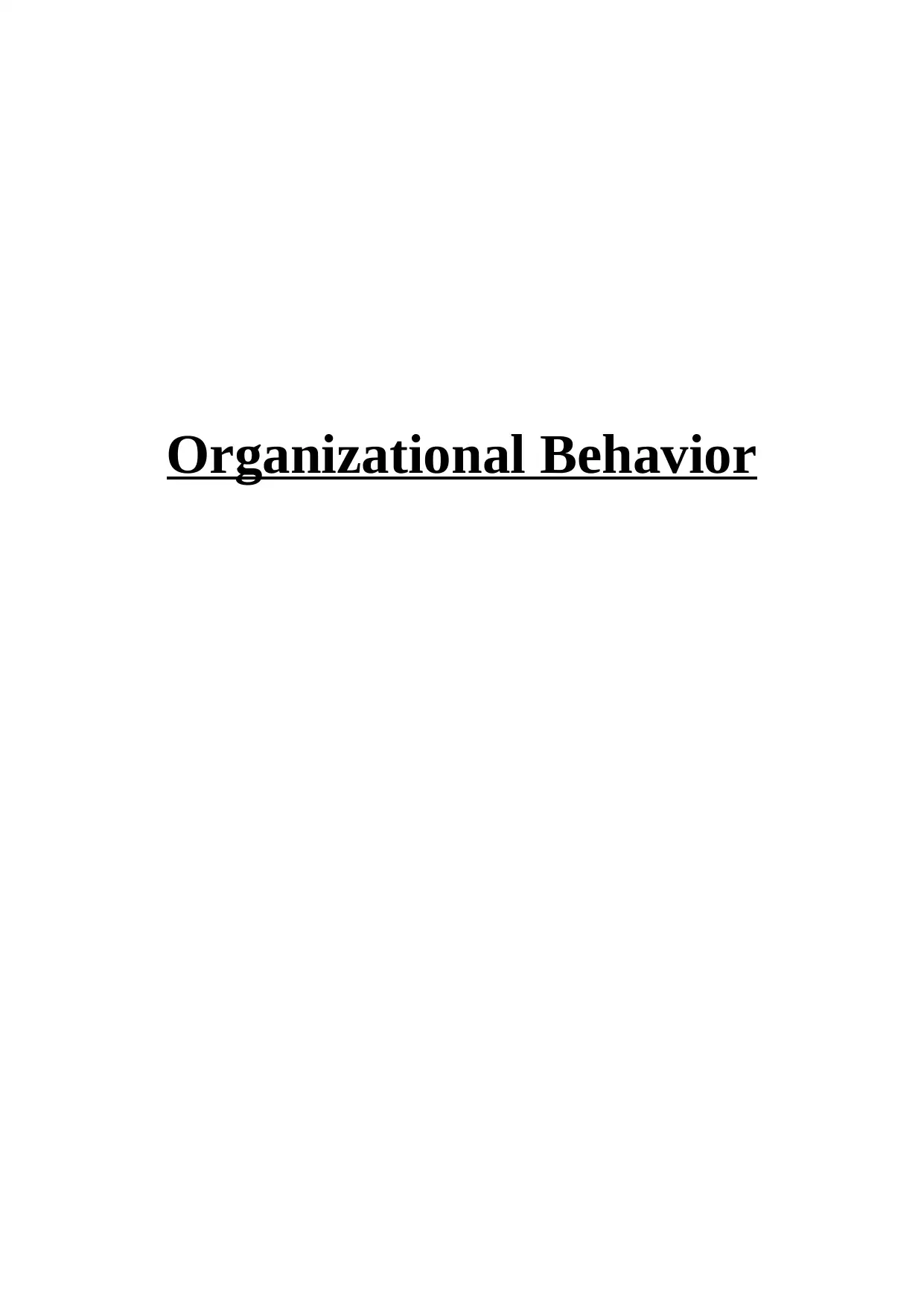
Organizational Behavior
Secure Best Marks with AI Grader
Need help grading? Try our AI Grader for instant feedback on your assignments.
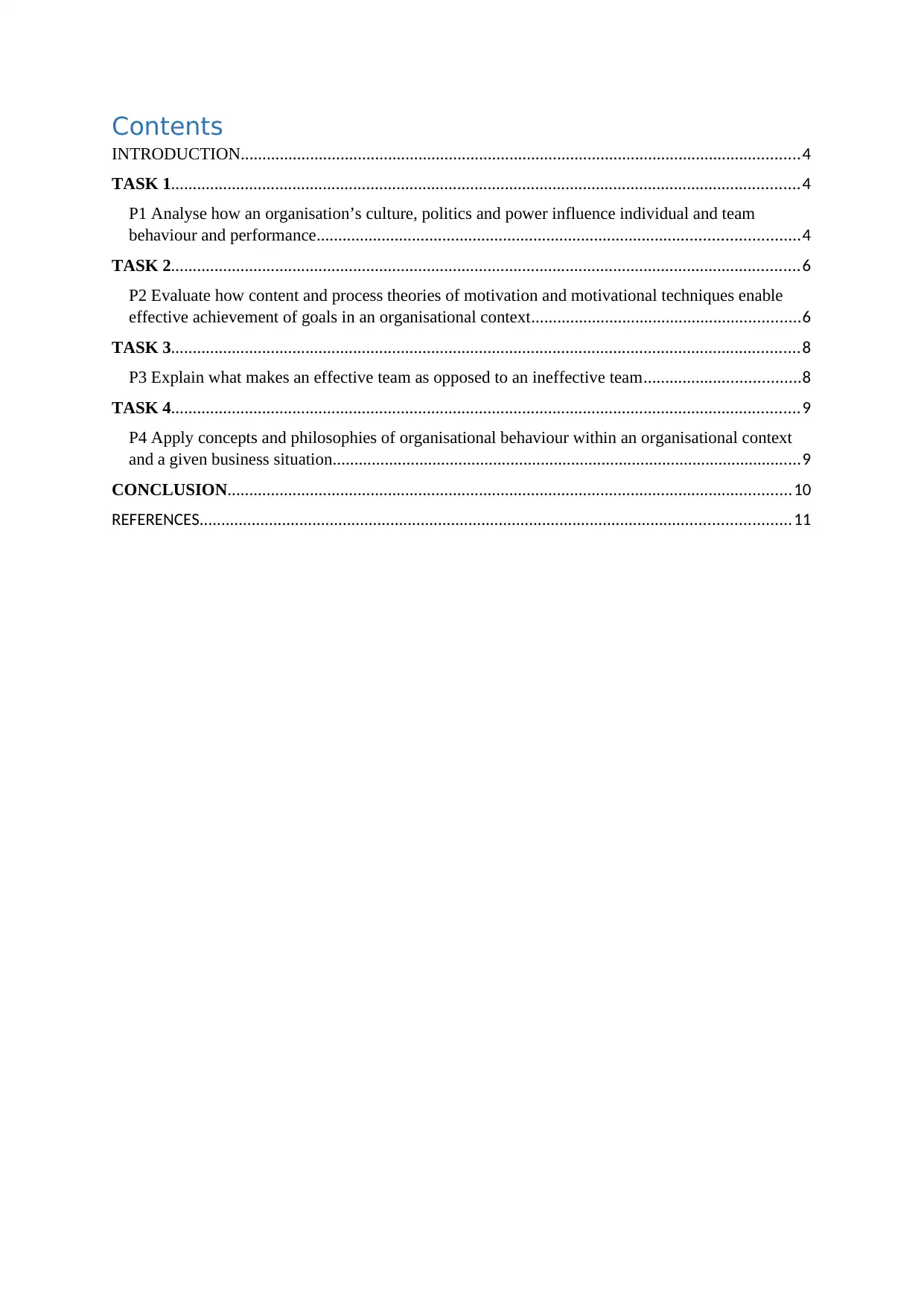
Contents
INTRODUCTION.................................................................................................................................4
TASK 1.................................................................................................................................................4
P1 Analyse how an organisation’s culture, politics and power influence individual and team
behaviour and performance...............................................................................................................4
TASK 2.................................................................................................................................................6
P2 Evaluate how content and process theories of motivation and motivational techniques enable
effective achievement of goals in an organisational context..............................................................6
TASK 3.................................................................................................................................................8
P3 Explain what makes an effective team as opposed to an ineffective team....................................8
TASK 4.................................................................................................................................................9
P4 Apply concepts and philosophies of organisational behaviour within an organisational context
and a given business situation............................................................................................................9
CONCLUSION..................................................................................................................................10
REFERENCES........................................................................................................................................11
INTRODUCTION.................................................................................................................................4
TASK 1.................................................................................................................................................4
P1 Analyse how an organisation’s culture, politics and power influence individual and team
behaviour and performance...............................................................................................................4
TASK 2.................................................................................................................................................6
P2 Evaluate how content and process theories of motivation and motivational techniques enable
effective achievement of goals in an organisational context..............................................................6
TASK 3.................................................................................................................................................8
P3 Explain what makes an effective team as opposed to an ineffective team....................................8
TASK 4.................................................................................................................................................9
P4 Apply concepts and philosophies of organisational behaviour within an organisational context
and a given business situation............................................................................................................9
CONCLUSION..................................................................................................................................10
REFERENCES........................................................................................................................................11
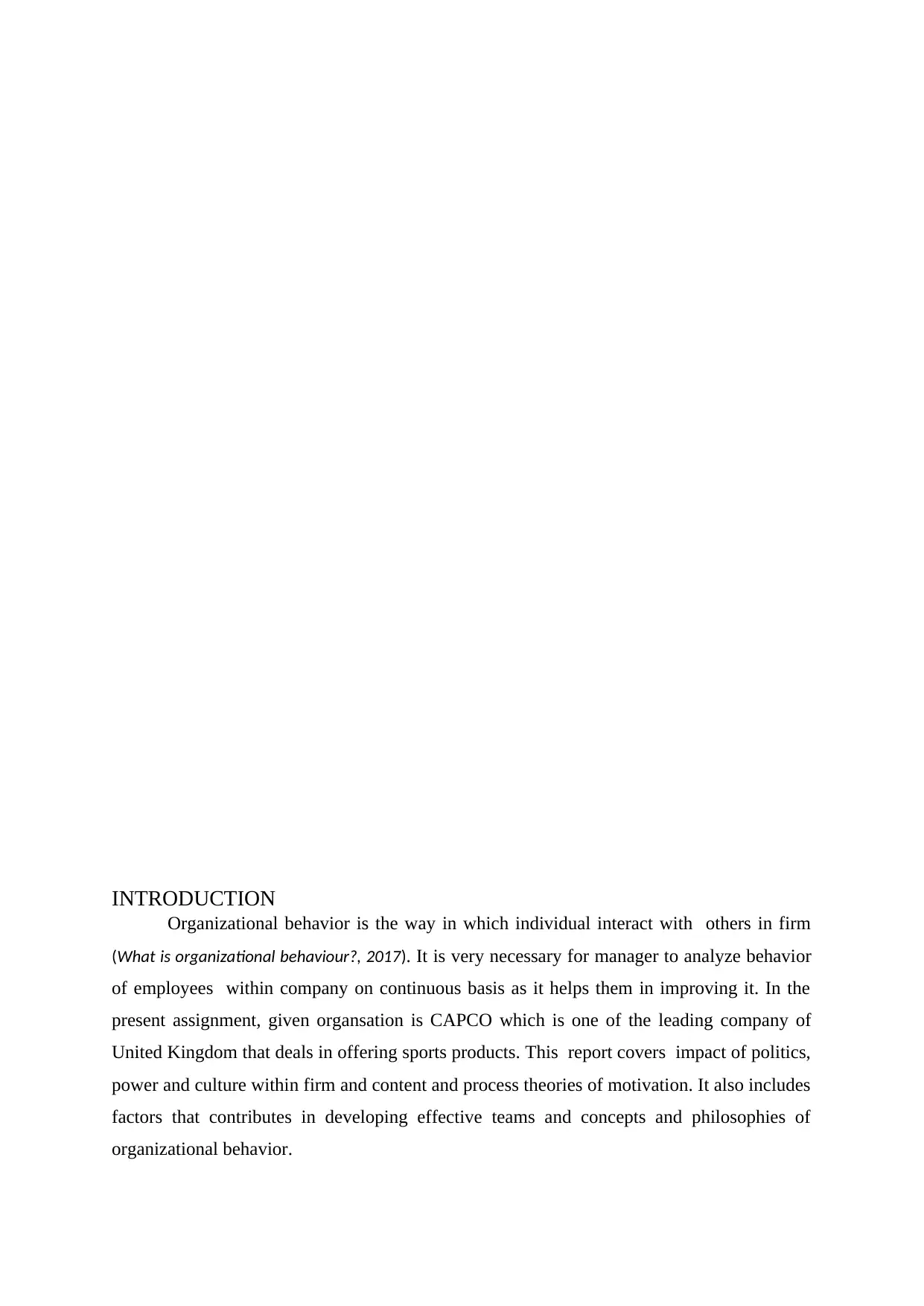
INTRODUCTION
Organizational behavior is the way in which individual interact with others in firm
(What is organizational behaviour?, 2017). It is very necessary for manager to analyze behavior
of employees within company on continuous basis as it helps them in improving it. In the
present assignment, given organsation is CAPCO which is one of the leading company of
United Kingdom that deals in offering sports products. This report covers impact of politics,
power and culture within firm and content and process theories of motivation. It also includes
factors that contributes in developing effective teams and concepts and philosophies of
organizational behavior.
Organizational behavior is the way in which individual interact with others in firm
(What is organizational behaviour?, 2017). It is very necessary for manager to analyze behavior
of employees within company on continuous basis as it helps them in improving it. In the
present assignment, given organsation is CAPCO which is one of the leading company of
United Kingdom that deals in offering sports products. This report covers impact of politics,
power and culture within firm and content and process theories of motivation. It also includes
factors that contributes in developing effective teams and concepts and philosophies of
organizational behavior.
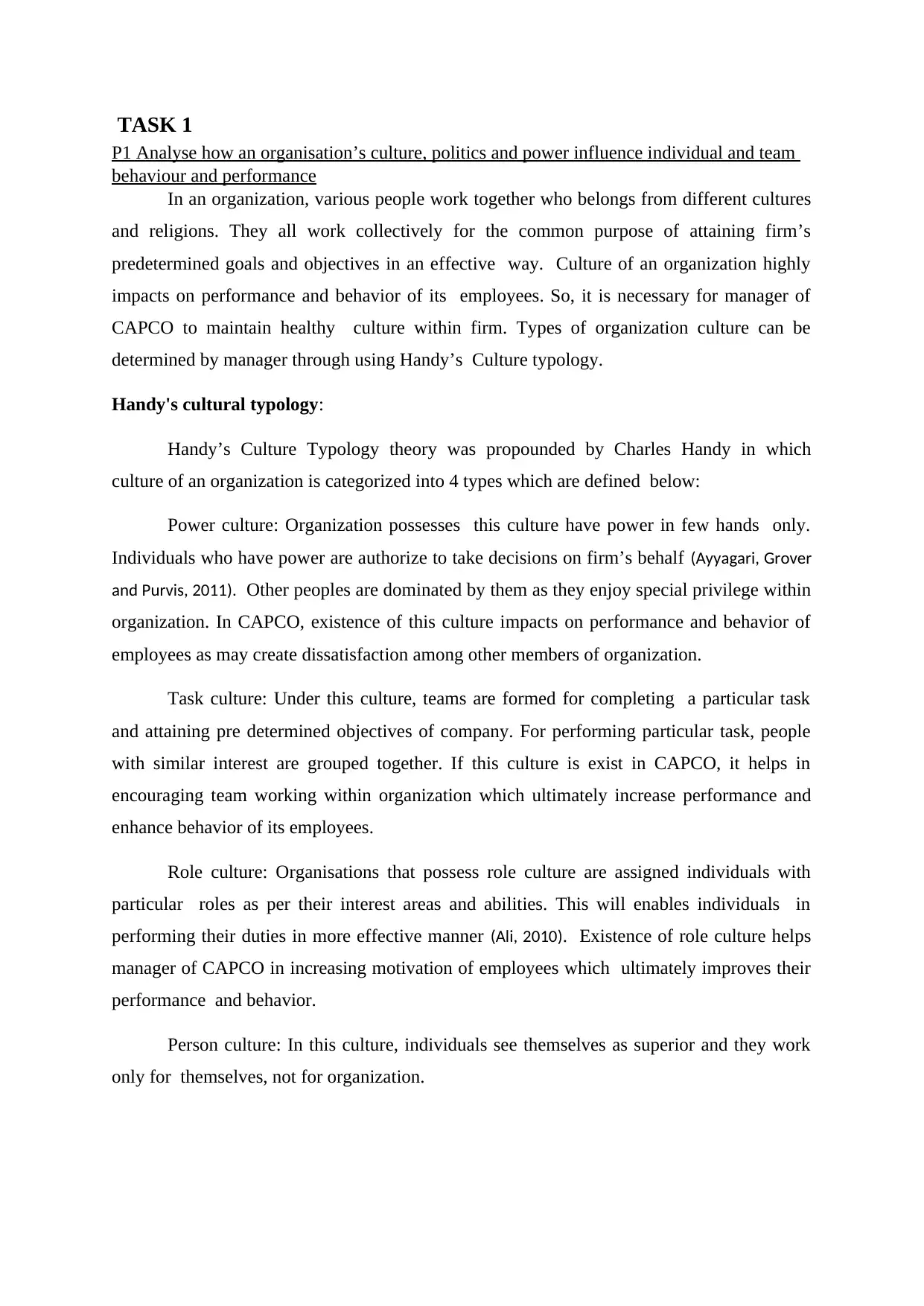
TASK 1
P1 Analyse how an organisation’s culture, politics and power influence individual and team
behaviour and performance
In an organization, various people work together who belongs from different cultures
and religions. They all work collectively for the common purpose of attaining firm’s
predetermined goals and objectives in an effective way. Culture of an organization highly
impacts on performance and behavior of its employees. So, it is necessary for manager of
CAPCO to maintain healthy culture within firm. Types of organization culture can be
determined by manager through using Handy’s Culture typology.
Handy's cultural typology:
Handy’s Culture Typology theory was propounded by Charles Handy in which
culture of an organization is categorized into 4 types which are defined below:
Power culture: Organization possesses this culture have power in few hands only.
Individuals who have power are authorize to take decisions on firm’s behalf (Ayyagari, Grover
and Purvis, 2011). Other peoples are dominated by them as they enjoy special privilege within
organization. In CAPCO, existence of this culture impacts on performance and behavior of
employees as may create dissatisfaction among other members of organization.
Task culture: Under this culture, teams are formed for completing a particular task
and attaining pre determined objectives of company. For performing particular task, people
with similar interest are grouped together. If this culture is exist in CAPCO, it helps in
encouraging team working within organization which ultimately increase performance and
enhance behavior of its employees.
Role culture: Organisations that possess role culture are assigned individuals with
particular roles as per their interest areas and abilities. This will enables individuals in
performing their duties in more effective manner (Ali, 2010). Existence of role culture helps
manager of CAPCO in increasing motivation of employees which ultimately improves their
performance and behavior.
Person culture: In this culture, individuals see themselves as superior and they work
only for themselves, not for organization.
P1 Analyse how an organisation’s culture, politics and power influence individual and team
behaviour and performance
In an organization, various people work together who belongs from different cultures
and religions. They all work collectively for the common purpose of attaining firm’s
predetermined goals and objectives in an effective way. Culture of an organization highly
impacts on performance and behavior of its employees. So, it is necessary for manager of
CAPCO to maintain healthy culture within firm. Types of organization culture can be
determined by manager through using Handy’s Culture typology.
Handy's cultural typology:
Handy’s Culture Typology theory was propounded by Charles Handy in which
culture of an organization is categorized into 4 types which are defined below:
Power culture: Organization possesses this culture have power in few hands only.
Individuals who have power are authorize to take decisions on firm’s behalf (Ayyagari, Grover
and Purvis, 2011). Other peoples are dominated by them as they enjoy special privilege within
organization. In CAPCO, existence of this culture impacts on performance and behavior of
employees as may create dissatisfaction among other members of organization.
Task culture: Under this culture, teams are formed for completing a particular task
and attaining pre determined objectives of company. For performing particular task, people
with similar interest are grouped together. If this culture is exist in CAPCO, it helps in
encouraging team working within organization which ultimately increase performance and
enhance behavior of its employees.
Role culture: Organisations that possess role culture are assigned individuals with
particular roles as per their interest areas and abilities. This will enables individuals in
performing their duties in more effective manner (Ali, 2010). Existence of role culture helps
manager of CAPCO in increasing motivation of employees which ultimately improves their
performance and behavior.
Person culture: In this culture, individuals see themselves as superior and they work
only for themselves, not for organization.
Secure Best Marks with AI Grader
Need help grading? Try our AI Grader for instant feedback on your assignments.
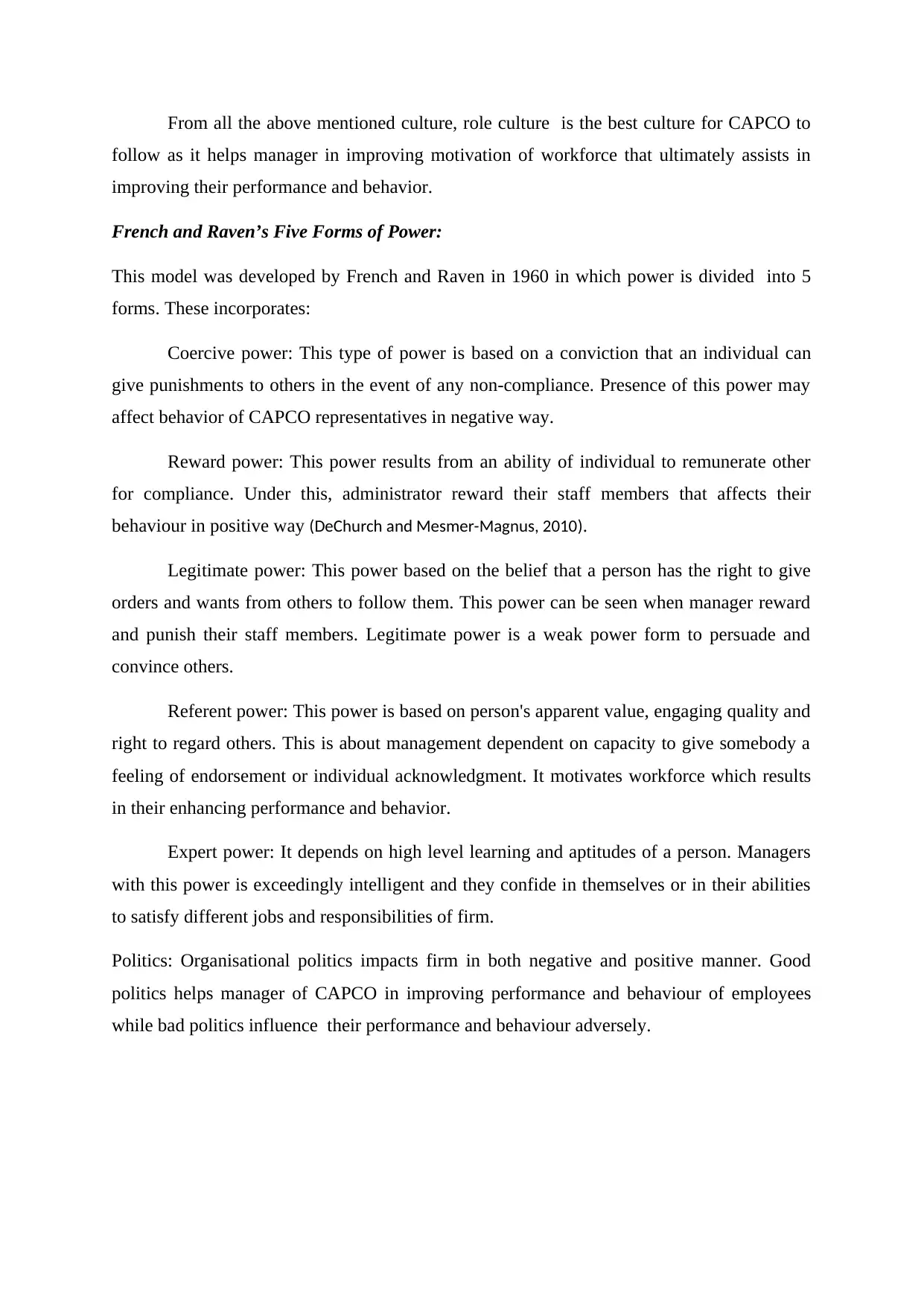
From all the above mentioned culture, role culture is the best culture for CAPCO to
follow as it helps manager in improving motivation of workforce that ultimately assists in
improving their performance and behavior.
French and Raven’s Five Forms of Power:
This model was developed by French and Raven in 1960 in which power is divided into 5
forms. These incorporates:
Coercive power: This type of power is based on a conviction that an individual can
give punishments to others in the event of any non-compliance. Presence of this power may
affect behavior of CAPCO representatives in negative way.
Reward power: This power results from an ability of individual to remunerate other
for compliance. Under this, administrator reward their staff members that affects their
behaviour in positive way (DeChurch and Mesmer-Magnus, 2010).
Legitimate power: This power based on the belief that a person has the right to give
orders and wants from others to follow them. This power can be seen when manager reward
and punish their staff members. Legitimate power is a weak power form to persuade and
convince others.
Referent power: This power is based on person's apparent value, engaging quality and
right to regard others. This is about management dependent on capacity to give somebody a
feeling of endorsement or individual acknowledgment. It motivates workforce which results
in their enhancing performance and behavior.
Expert power: It depends on high level learning and aptitudes of a person. Managers
with this power is exceedingly intelligent and they confide in themselves or in their abilities
to satisfy different jobs and responsibilities of firm.
Politics: Organisational politics impacts firm in both negative and positive manner. Good
politics helps manager of CAPCO in improving performance and behaviour of employees
while bad politics influence their performance and behaviour adversely.
follow as it helps manager in improving motivation of workforce that ultimately assists in
improving their performance and behavior.
French and Raven’s Five Forms of Power:
This model was developed by French and Raven in 1960 in which power is divided into 5
forms. These incorporates:
Coercive power: This type of power is based on a conviction that an individual can
give punishments to others in the event of any non-compliance. Presence of this power may
affect behavior of CAPCO representatives in negative way.
Reward power: This power results from an ability of individual to remunerate other
for compliance. Under this, administrator reward their staff members that affects their
behaviour in positive way (DeChurch and Mesmer-Magnus, 2010).
Legitimate power: This power based on the belief that a person has the right to give
orders and wants from others to follow them. This power can be seen when manager reward
and punish their staff members. Legitimate power is a weak power form to persuade and
convince others.
Referent power: This power is based on person's apparent value, engaging quality and
right to regard others. This is about management dependent on capacity to give somebody a
feeling of endorsement or individual acknowledgment. It motivates workforce which results
in their enhancing performance and behavior.
Expert power: It depends on high level learning and aptitudes of a person. Managers
with this power is exceedingly intelligent and they confide in themselves or in their abilities
to satisfy different jobs and responsibilities of firm.
Politics: Organisational politics impacts firm in both negative and positive manner. Good
politics helps manager of CAPCO in improving performance and behaviour of employees
while bad politics influence their performance and behaviour adversely.

TASK 2
P2 Evaluate how content and process theories of motivation and motivational techniques
enable effective achievement of goals in an organisational context
Motivation is the inner urge that encourage an individual to do something. For
attaining goals and objectives of firm effectively, it is highly essential that employees are
motivated. Skilled and competent workforce are more able to execute operations effectively
and attain objectives of firm (Baum, Frese and Baron, 2014). Motivation stimulates people to
put their efforts and work for accomplishment of firm’s objectives. So, it is highly essential
for manager of CAPCO to improve morale and motivation of manpower as it ultimately helps
in improving performance of firm. For improving employees motivation, different theories
needs to be applied by manager which are defined below:
Content theory: Main emphasis of this theory is to motivate individuals at workplace. There
are some factors that directly or indirectly impact on performance of workforce. Such factors
needs to be considered by manager so that their performance can be improved. Content
theory of motivation is defined below:
Maslow’s hierarchy of needs theory:
Motivation theory is propounded by Abraham Maslow in which needs are divided
into five levels which are defined below:
Physiological needs: In this, basic needs of an individual which is very essential for
survival. It includes food, water and shelter (Haslamand et. al., 2014). Satisfaction of
physiological needs is very essential as it helps in increasing motivation level of
employees. So, it is highly essential for managers of CAPCO to consider basic needs
of workers when formulating compensation policies. This will help in retaining
employees within firm for longer term and reducing their turnover rate.
Safety needs: This is the second motivational need of individuals which includes
safety from physical, emotional and environmental changes. In order to satisfy this
need, it is required by manager of CAPCO to provide financial and job security to its
workforce so that they stay motivated and work towards attaining goals and objectives
of company.
Social needs: This is the third need in which individual wants belongingness,
affection, love and care for their friends, family members and others. It is required by
manager of CAPCO to promote team working with in organisation so that skills and
P2 Evaluate how content and process theories of motivation and motivational techniques
enable effective achievement of goals in an organisational context
Motivation is the inner urge that encourage an individual to do something. For
attaining goals and objectives of firm effectively, it is highly essential that employees are
motivated. Skilled and competent workforce are more able to execute operations effectively
and attain objectives of firm (Baum, Frese and Baron, 2014). Motivation stimulates people to
put their efforts and work for accomplishment of firm’s objectives. So, it is highly essential
for manager of CAPCO to improve morale and motivation of manpower as it ultimately helps
in improving performance of firm. For improving employees motivation, different theories
needs to be applied by manager which are defined below:
Content theory: Main emphasis of this theory is to motivate individuals at workplace. There
are some factors that directly or indirectly impact on performance of workforce. Such factors
needs to be considered by manager so that their performance can be improved. Content
theory of motivation is defined below:
Maslow’s hierarchy of needs theory:
Motivation theory is propounded by Abraham Maslow in which needs are divided
into five levels which are defined below:
Physiological needs: In this, basic needs of an individual which is very essential for
survival. It includes food, water and shelter (Haslamand et. al., 2014). Satisfaction of
physiological needs is very essential as it helps in increasing motivation level of
employees. So, it is highly essential for managers of CAPCO to consider basic needs
of workers when formulating compensation policies. This will help in retaining
employees within firm for longer term and reducing their turnover rate.
Safety needs: This is the second motivational need of individuals which includes
safety from physical, emotional and environmental changes. In order to satisfy this
need, it is required by manager of CAPCO to provide financial and job security to its
workforce so that they stay motivated and work towards attaining goals and objectives
of company.
Social needs: This is the third need in which individual wants belongingness,
affection, love and care for their friends, family members and others. It is required by
manager of CAPCO to promote team working with in organisation so that skills and
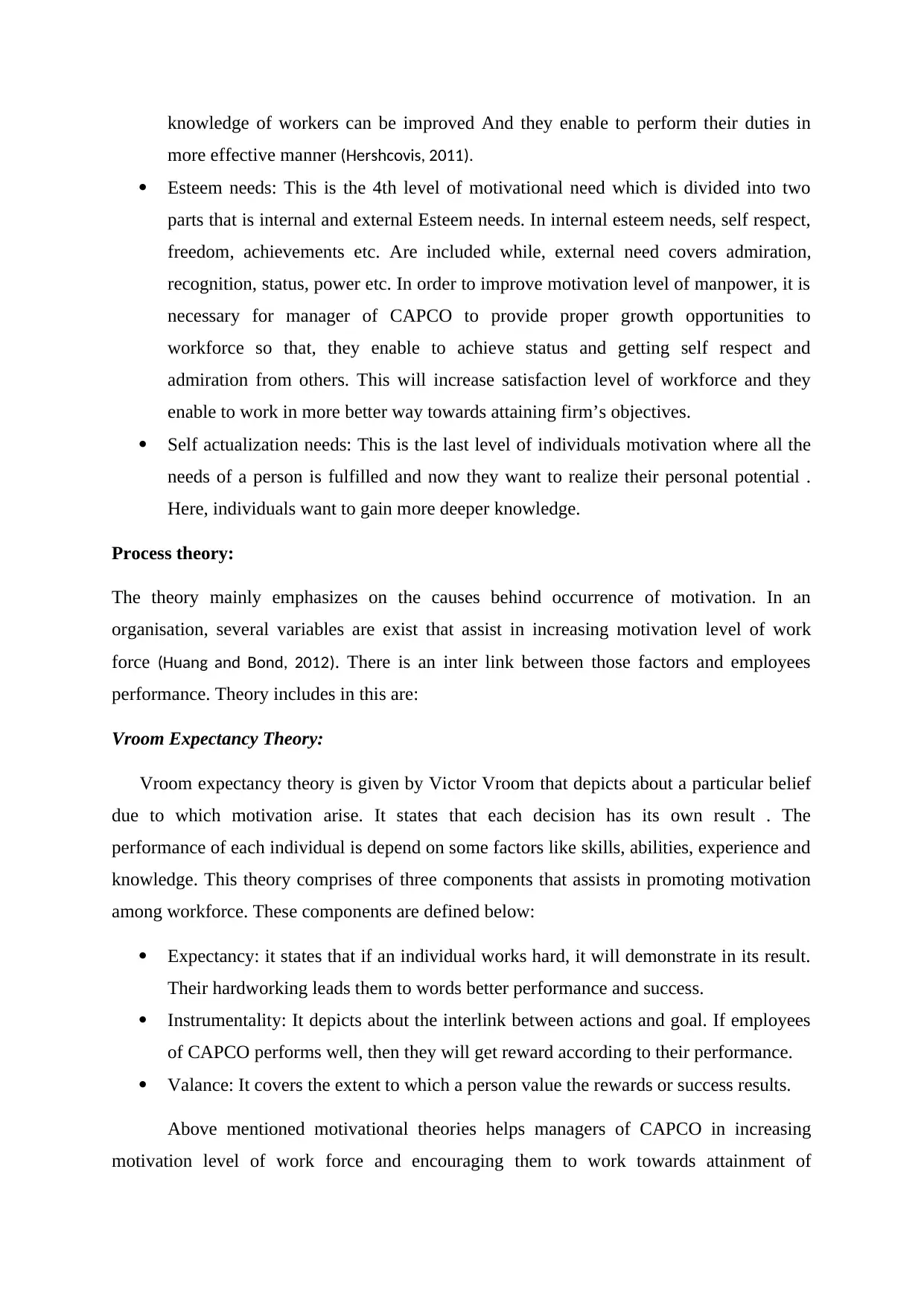
knowledge of workers can be improved And they enable to perform their duties in
more effective manner (Hershcovis, 2011).
Esteem needs: This is the 4th level of motivational need which is divided into two
parts that is internal and external Esteem needs. In internal esteem needs, self respect,
freedom, achievements etc. Are included while, external need covers admiration,
recognition, status, power etc. In order to improve motivation level of manpower, it is
necessary for manager of CAPCO to provide proper growth opportunities to
workforce so that, they enable to achieve status and getting self respect and
admiration from others. This will increase satisfaction level of workforce and they
enable to work in more better way towards attaining firm’s objectives.
Self actualization needs: This is the last level of individuals motivation where all the
needs of a person is fulfilled and now they want to realize their personal potential .
Here, individuals want to gain more deeper knowledge.
Process theory:
The theory mainly emphasizes on the causes behind occurrence of motivation. In an
organisation, several variables are exist that assist in increasing motivation level of work
force (Huang and Bond, 2012). There is an inter link between those factors and employees
performance. Theory includes in this are:
Vroom Expectancy Theory:
Vroom expectancy theory is given by Victor Vroom that depicts about a particular belief
due to which motivation arise. It states that each decision has its own result . The
performance of each individual is depend on some factors like skills, abilities, experience and
knowledge. This theory comprises of three components that assists in promoting motivation
among workforce. These components are defined below:
Expectancy: it states that if an individual works hard, it will demonstrate in its result.
Their hardworking leads them to words better performance and success.
Instrumentality: It depicts about the interlink between actions and goal. If employees
of CAPCO performs well, then they will get reward according to their performance.
Valance: It covers the extent to which a person value the rewards or success results.
Above mentioned motivational theories helps managers of CAPCO in increasing
motivation level of work force and encouraging them to work towards attainment of
more effective manner (Hershcovis, 2011).
Esteem needs: This is the 4th level of motivational need which is divided into two
parts that is internal and external Esteem needs. In internal esteem needs, self respect,
freedom, achievements etc. Are included while, external need covers admiration,
recognition, status, power etc. In order to improve motivation level of manpower, it is
necessary for manager of CAPCO to provide proper growth opportunities to
workforce so that, they enable to achieve status and getting self respect and
admiration from others. This will increase satisfaction level of workforce and they
enable to work in more better way towards attaining firm’s objectives.
Self actualization needs: This is the last level of individuals motivation where all the
needs of a person is fulfilled and now they want to realize their personal potential .
Here, individuals want to gain more deeper knowledge.
Process theory:
The theory mainly emphasizes on the causes behind occurrence of motivation. In an
organisation, several variables are exist that assist in increasing motivation level of work
force (Huang and Bond, 2012). There is an inter link between those factors and employees
performance. Theory includes in this are:
Vroom Expectancy Theory:
Vroom expectancy theory is given by Victor Vroom that depicts about a particular belief
due to which motivation arise. It states that each decision has its own result . The
performance of each individual is depend on some factors like skills, abilities, experience and
knowledge. This theory comprises of three components that assists in promoting motivation
among workforce. These components are defined below:
Expectancy: it states that if an individual works hard, it will demonstrate in its result.
Their hardworking leads them to words better performance and success.
Instrumentality: It depicts about the interlink between actions and goal. If employees
of CAPCO performs well, then they will get reward according to their performance.
Valance: It covers the extent to which a person value the rewards or success results.
Above mentioned motivational theories helps managers of CAPCO in increasing
motivation level of work force and encouraging them to work towards attainment of
Paraphrase This Document
Need a fresh take? Get an instant paraphrase of this document with our AI Paraphraser
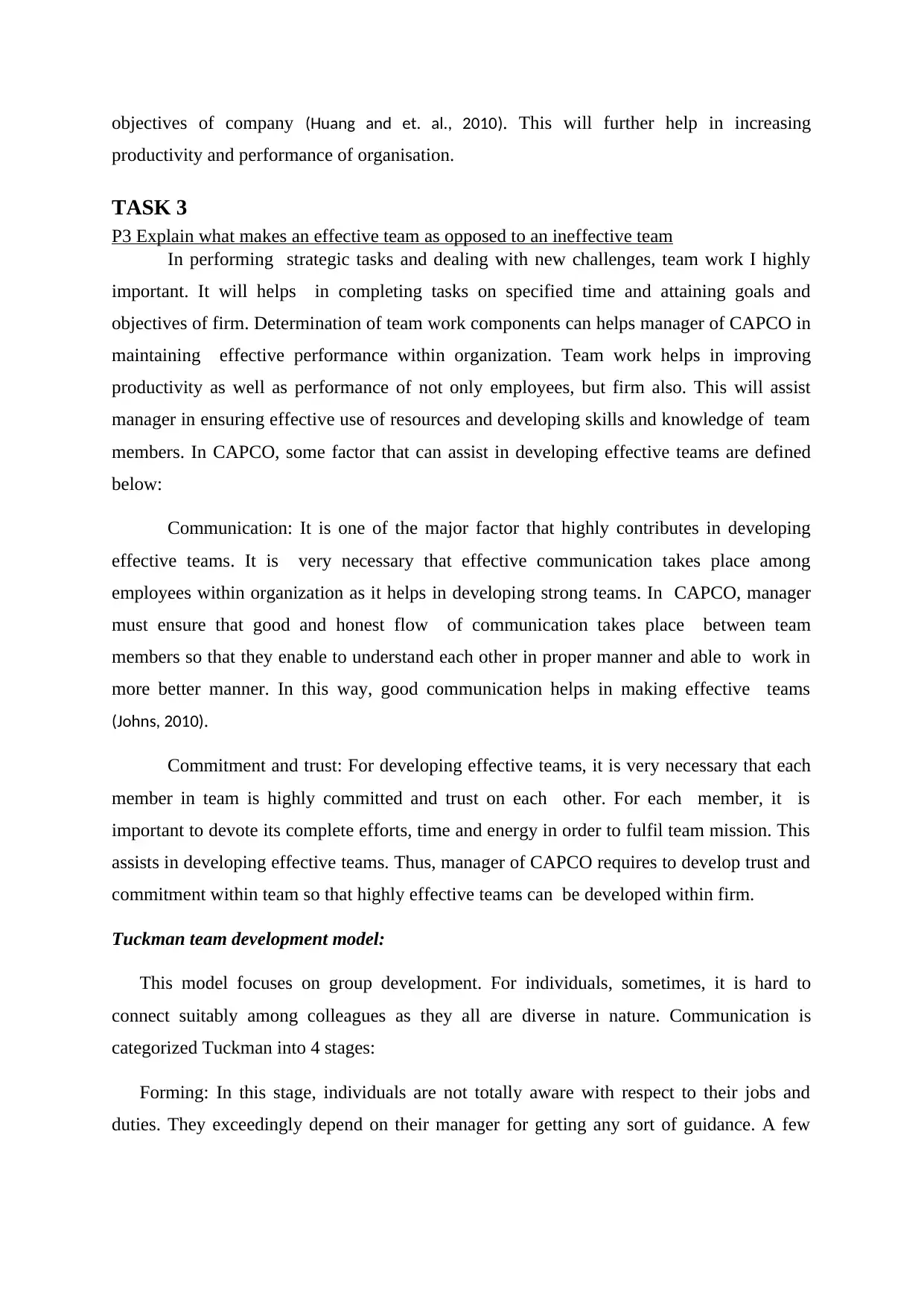
objectives of company (Huang and et. al., 2010). This will further help in increasing
productivity and performance of organisation.
TASK 3
P3 Explain what makes an effective team as opposed to an ineffective team
In performing strategic tasks and dealing with new challenges, team work I highly
important. It will helps in completing tasks on specified time and attaining goals and
objectives of firm. Determination of team work components can helps manager of CAPCO in
maintaining effective performance within organization. Team work helps in improving
productivity as well as performance of not only employees, but firm also. This will assist
manager in ensuring effective use of resources and developing skills and knowledge of team
members. In CAPCO, some factor that can assist in developing effective teams are defined
below:
Communication: It is one of the major factor that highly contributes in developing
effective teams. It is very necessary that effective communication takes place among
employees within organization as it helps in developing strong teams. In CAPCO, manager
must ensure that good and honest flow of communication takes place between team
members so that they enable to understand each other in proper manner and able to work in
more better manner. In this way, good communication helps in making effective teams
(Johns, 2010).
Commitment and trust: For developing effective teams, it is very necessary that each
member in team is highly committed and trust on each other. For each member, it is
important to devote its complete efforts, time and energy in order to fulfil team mission. This
assists in developing effective teams. Thus, manager of CAPCO requires to develop trust and
commitment within team so that highly effective teams can be developed within firm.
Tuckman team development model:
This model focuses on group development. For individuals, sometimes, it is hard to
connect suitably among colleagues as they all are diverse in nature. Communication is
categorized Tuckman into 4 stages:
Forming: In this stage, individuals are not totally aware with respect to their jobs and
duties. They exceedingly depend on their manager for getting any sort of guidance. A few
productivity and performance of organisation.
TASK 3
P3 Explain what makes an effective team as opposed to an ineffective team
In performing strategic tasks and dealing with new challenges, team work I highly
important. It will helps in completing tasks on specified time and attaining goals and
objectives of firm. Determination of team work components can helps manager of CAPCO in
maintaining effective performance within organization. Team work helps in improving
productivity as well as performance of not only employees, but firm also. This will assist
manager in ensuring effective use of resources and developing skills and knowledge of team
members. In CAPCO, some factor that can assist in developing effective teams are defined
below:
Communication: It is one of the major factor that highly contributes in developing
effective teams. It is very necessary that effective communication takes place among
employees within organization as it helps in developing strong teams. In CAPCO, manager
must ensure that good and honest flow of communication takes place between team
members so that they enable to understand each other in proper manner and able to work in
more better manner. In this way, good communication helps in making effective teams
(Johns, 2010).
Commitment and trust: For developing effective teams, it is very necessary that each
member in team is highly committed and trust on each other. For each member, it is
important to devote its complete efforts, time and energy in order to fulfil team mission. This
assists in developing effective teams. Thus, manager of CAPCO requires to develop trust and
commitment within team so that highly effective teams can be developed within firm.
Tuckman team development model:
This model focuses on group development. For individuals, sometimes, it is hard to
connect suitably among colleagues as they all are diverse in nature. Communication is
categorized Tuckman into 4 stages:
Forming: In this stage, individuals are not totally aware with respect to their jobs and
duties. They exceedingly depend on their manager for getting any sort of guidance. A few
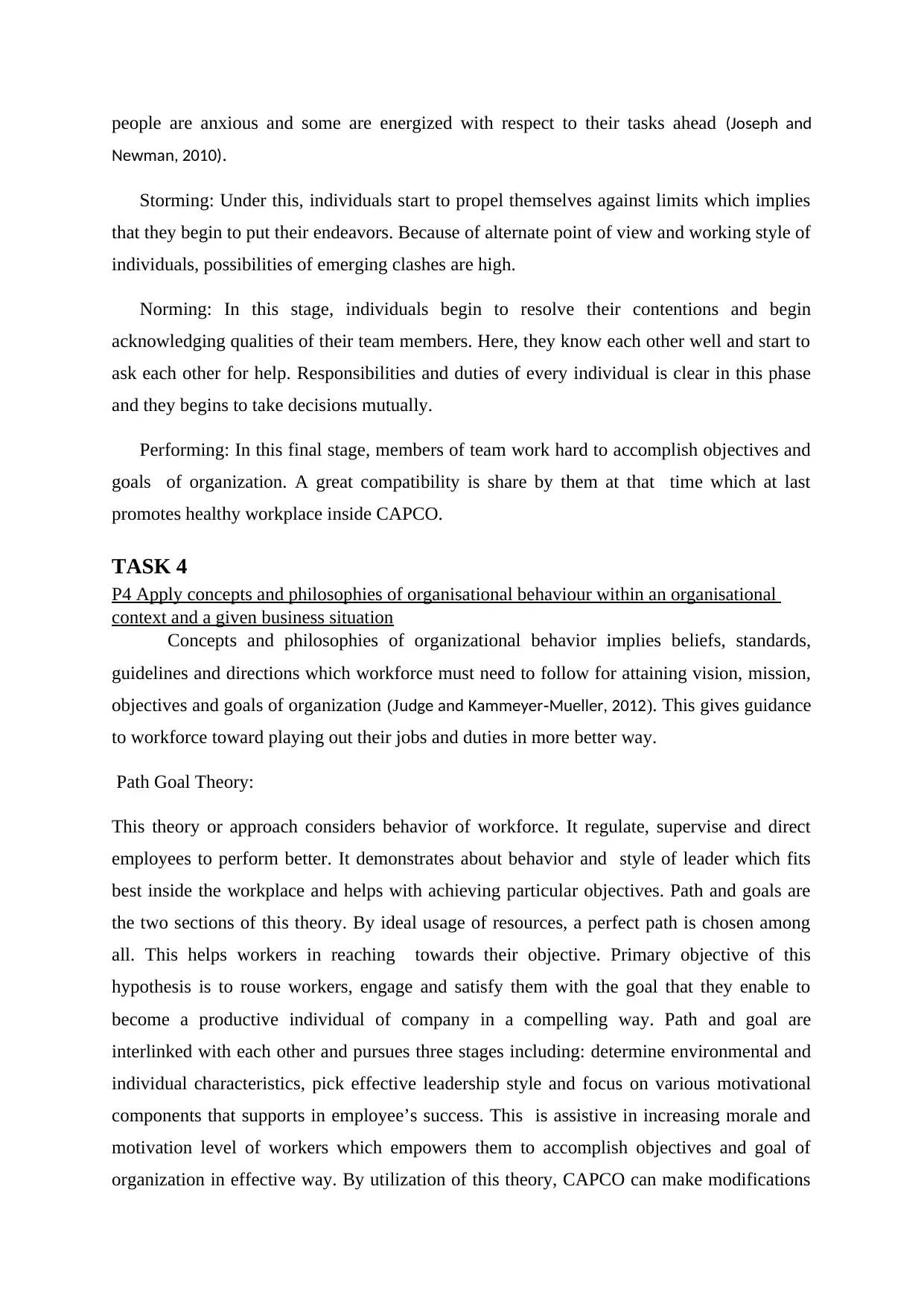
people are anxious and some are energized with respect to their tasks ahead (Joseph and
Newman, 2010).
Storming: Under this, individuals start to propel themselves against limits which implies
that they begin to put their endeavors. Because of alternate point of view and working style of
individuals, possibilities of emerging clashes are high.
Norming: In this stage, individuals begin to resolve their contentions and begin
acknowledging qualities of their team members. Here, they know each other well and start to
ask each other for help. Responsibilities and duties of every individual is clear in this phase
and they begins to take decisions mutually.
Performing: In this final stage, members of team work hard to accomplish objectives and
goals of organization. A great compatibility is share by them at that time which at last
promotes healthy workplace inside CAPCO.
TASK 4
P4 Apply concepts and philosophies of organisational behaviour within an organisational
context and a given business situation
Concepts and philosophies of organizational behavior implies beliefs, standards,
guidelines and directions which workforce must need to follow for attaining vision, mission,
objectives and goals of organization (Judge and Kammeyer Mueller, 2012‐ ). This gives guidance
to workforce toward playing out their jobs and duties in more better way.
Path Goal Theory:
This theory or approach considers behavior of workforce. It regulate, supervise and direct
employees to perform better. It demonstrates about behavior and style of leader which fits
best inside the workplace and helps with achieving particular objectives. Path and goals are
the two sections of this theory. By ideal usage of resources, a perfect path is chosen among
all. This helps workers in reaching towards their objective. Primary objective of this
hypothesis is to rouse workers, engage and satisfy them with the goal that they enable to
become a productive individual of company in a compelling way. Path and goal are
interlinked with each other and pursues three stages including: determine environmental and
individual characteristics, pick effective leadership style and focus on various motivational
components that supports in employee’s success. This is assistive in increasing morale and
motivation level of workers which empowers them to accomplish objectives and goal of
organization in effective way. By utilization of this theory, CAPCO can make modifications
Newman, 2010).
Storming: Under this, individuals start to propel themselves against limits which implies
that they begin to put their endeavors. Because of alternate point of view and working style of
individuals, possibilities of emerging clashes are high.
Norming: In this stage, individuals begin to resolve their contentions and begin
acknowledging qualities of their team members. Here, they know each other well and start to
ask each other for help. Responsibilities and duties of every individual is clear in this phase
and they begins to take decisions mutually.
Performing: In this final stage, members of team work hard to accomplish objectives and
goals of organization. A great compatibility is share by them at that time which at last
promotes healthy workplace inside CAPCO.
TASK 4
P4 Apply concepts and philosophies of organisational behaviour within an organisational
context and a given business situation
Concepts and philosophies of organizational behavior implies beliefs, standards,
guidelines and directions which workforce must need to follow for attaining vision, mission,
objectives and goals of organization (Judge and Kammeyer Mueller, 2012‐ ). This gives guidance
to workforce toward playing out their jobs and duties in more better way.
Path Goal Theory:
This theory or approach considers behavior of workforce. It regulate, supervise and direct
employees to perform better. It demonstrates about behavior and style of leader which fits
best inside the workplace and helps with achieving particular objectives. Path and goals are
the two sections of this theory. By ideal usage of resources, a perfect path is chosen among
all. This helps workers in reaching towards their objective. Primary objective of this
hypothesis is to rouse workers, engage and satisfy them with the goal that they enable to
become a productive individual of company in a compelling way. Path and goal are
interlinked with each other and pursues three stages including: determine environmental and
individual characteristics, pick effective leadership style and focus on various motivational
components that supports in employee’s success. This is assistive in increasing morale and
motivation level of workers which empowers them to accomplish objectives and goal of
organization in effective way. By utilization of this theory, CAPCO can make modifications
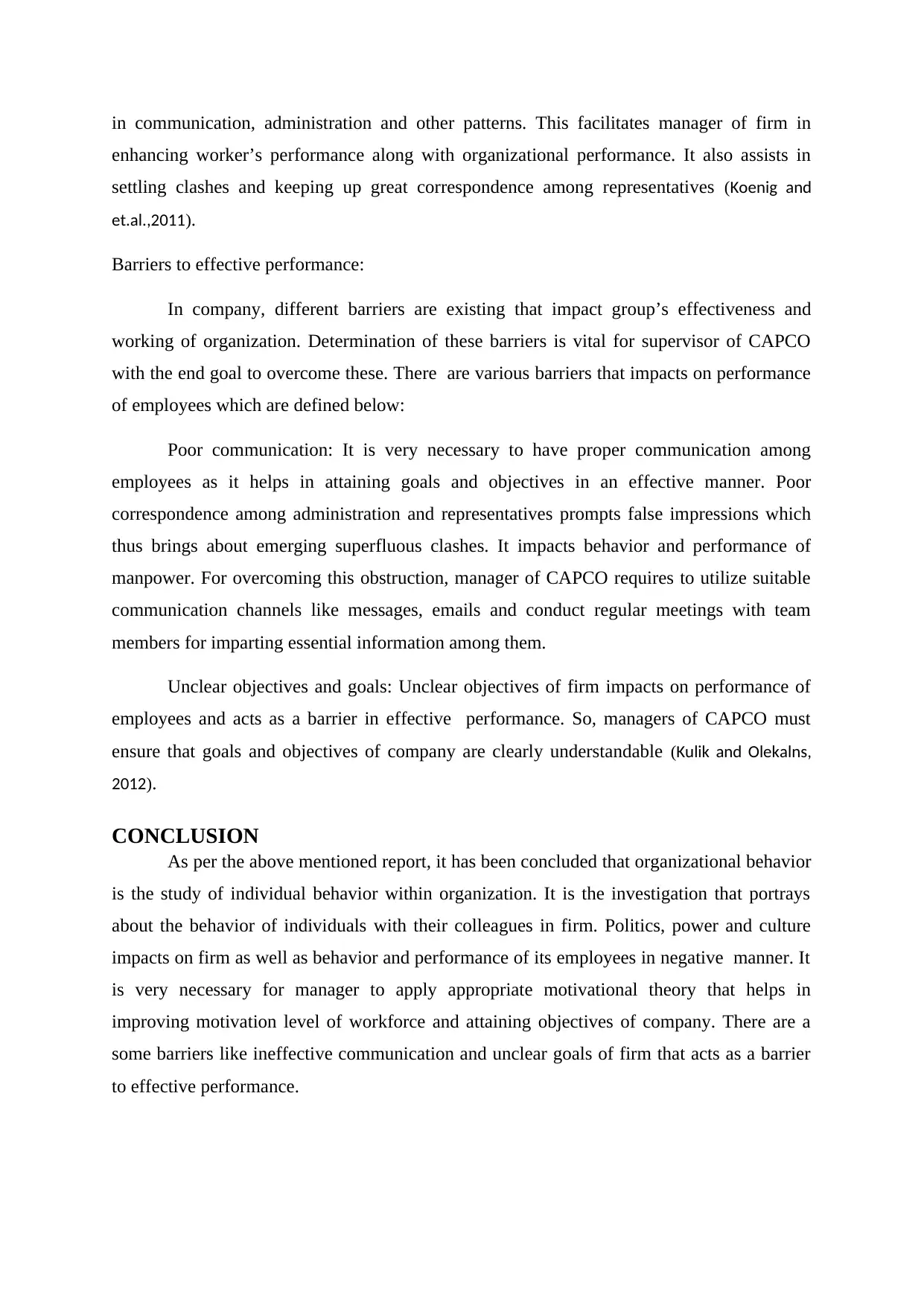
in communication, administration and other patterns. This facilitates manager of firm in
enhancing worker’s performance along with organizational performance. It also assists in
settling clashes and keeping up great correspondence among representatives (Koenig and
et.al.,2011).
Barriers to effective performance:
In company, different barriers are existing that impact group’s effectiveness and
working of organization. Determination of these barriers is vital for supervisor of CAPCO
with the end goal to overcome these. There are various barriers that impacts on performance
of employees which are defined below:
Poor communication: It is very necessary to have proper communication among
employees as it helps in attaining goals and objectives in an effective manner. Poor
correspondence among administration and representatives prompts false impressions which
thus brings about emerging superfluous clashes. It impacts behavior and performance of
manpower. For overcoming this obstruction, manager of CAPCO requires to utilize suitable
communication channels like messages, emails and conduct regular meetings with team
members for imparting essential information among them.
Unclear objectives and goals: Unclear objectives of firm impacts on performance of
employees and acts as a barrier in effective performance. So, managers of CAPCO must
ensure that goals and objectives of company are clearly understandable (Kulik and Olekalns,
2012).
CONCLUSION
As per the above mentioned report, it has been concluded that organizational behavior
is the study of individual behavior within organization. It is the investigation that portrays
about the behavior of individuals with their colleagues in firm. Politics, power and culture
impacts on firm as well as behavior and performance of its employees in negative manner. It
is very necessary for manager to apply appropriate motivational theory that helps in
improving motivation level of workforce and attaining objectives of company. There are a
some barriers like ineffective communication and unclear goals of firm that acts as a barrier
to effective performance.
enhancing worker’s performance along with organizational performance. It also assists in
settling clashes and keeping up great correspondence among representatives (Koenig and
et.al.,2011).
Barriers to effective performance:
In company, different barriers are existing that impact group’s effectiveness and
working of organization. Determination of these barriers is vital for supervisor of CAPCO
with the end goal to overcome these. There are various barriers that impacts on performance
of employees which are defined below:
Poor communication: It is very necessary to have proper communication among
employees as it helps in attaining goals and objectives in an effective manner. Poor
correspondence among administration and representatives prompts false impressions which
thus brings about emerging superfluous clashes. It impacts behavior and performance of
manpower. For overcoming this obstruction, manager of CAPCO requires to utilize suitable
communication channels like messages, emails and conduct regular meetings with team
members for imparting essential information among them.
Unclear objectives and goals: Unclear objectives of firm impacts on performance of
employees and acts as a barrier in effective performance. So, managers of CAPCO must
ensure that goals and objectives of company are clearly understandable (Kulik and Olekalns,
2012).
CONCLUSION
As per the above mentioned report, it has been concluded that organizational behavior
is the study of individual behavior within organization. It is the investigation that portrays
about the behavior of individuals with their colleagues in firm. Politics, power and culture
impacts on firm as well as behavior and performance of its employees in negative manner. It
is very necessary for manager to apply appropriate motivational theory that helps in
improving motivation level of workforce and attaining objectives of company. There are a
some barriers like ineffective communication and unclear goals of firm that acts as a barrier
to effective performance.
Secure Best Marks with AI Grader
Need help grading? Try our AI Grader for instant feedback on your assignments.
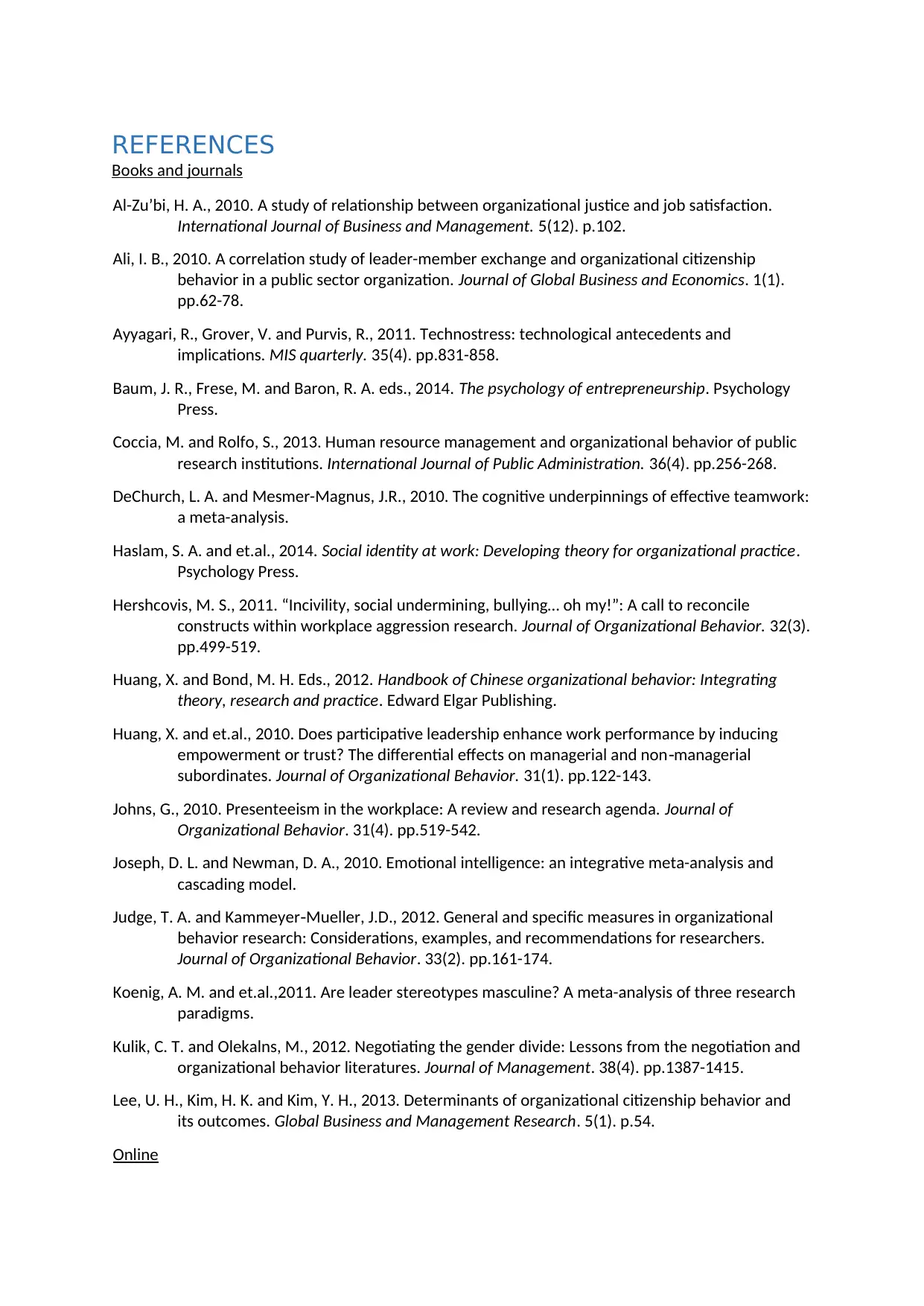
REFERENCES
Books and journals
Al-Zu’bi, H. A., 2010. A study of relationship between organizational justice and job satisfaction.
International Journal of Business and Management. 5(12). p.102.
Ali, I. B., 2010. A correlation study of leader-member exchange and organizational citizenship
behavior in a public sector organization. Journal of Global Business and Economics. 1(1).
pp.62-78.
Ayyagari, R., Grover, V. and Purvis, R., 2011. Technostress: technological antecedents and
implications. MIS quarterly. 35(4). pp.831-858.
Baum, J. R., Frese, M. and Baron, R. A. eds., 2014. The psychology of entrepreneurship. Psychology
Press.
Coccia, M. and Rolfo, S., 2013. Human resource management and organizational behavior of public
research institutions. International Journal of Public Administration. 36(4). pp.256-268.
DeChurch, L. A. and Mesmer-Magnus, J.R., 2010. The cognitive underpinnings of effective teamwork:
a meta-analysis.
Haslam, S. A. and et.al., 2014. Social identity at work: Developing theory for organizational practice.
Psychology Press.
Hershcovis, M. S., 2011. “Incivility, social undermining, bullying… oh my!”: A call to reconcile
constructs within workplace aggression research. Journal of Organizational Behavior. 32(3).
pp.499-519.
Huang, X. and Bond, M. H. Eds., 2012. Handbook of Chinese organizational behavior: Integrating
theory, research and practice. Edward Elgar Publishing.
Huang, X. and et.al., 2010. Does participative leadership enhance work performance by inducing
empowerment or trust? The differential effects on managerial and non managerial‐
subordinates. Journal of Organizational Behavior. 31(1). pp.122-143.
Johns, G., 2010. Presenteeism in the workplace: A review and research agenda. Journal of
Organizational Behavior. 31(4). pp.519-542.
Joseph, D. L. and Newman, D. A., 2010. Emotional intelligence: an integrative meta-analysis and
cascading model.
Judge, T. A. and Kammeyer Mueller, J.D., 2012. General and specific measures in organizational‐
behavior research: Considerations, examples, and recommendations for researchers.
Journal of Organizational Behavior. 33(2). pp.161-174.
Koenig, A. M. and et.al.,2011. Are leader stereotypes masculine? A meta-analysis of three research
paradigms.
Kulik, C. T. and Olekalns, M., 2012. Negotiating the gender divide: Lessons from the negotiation and
organizational behavior literatures. Journal of Management. 38(4). pp.1387-1415.
Lee, U. H., Kim, H. K. and Kim, Y. H., 2013. Determinants of organizational citizenship behavior and
its outcomes. Global Business and Management Research. 5(1). p.54.
Online
Books and journals
Al-Zu’bi, H. A., 2010. A study of relationship between organizational justice and job satisfaction.
International Journal of Business and Management. 5(12). p.102.
Ali, I. B., 2010. A correlation study of leader-member exchange and organizational citizenship
behavior in a public sector organization. Journal of Global Business and Economics. 1(1).
pp.62-78.
Ayyagari, R., Grover, V. and Purvis, R., 2011. Technostress: technological antecedents and
implications. MIS quarterly. 35(4). pp.831-858.
Baum, J. R., Frese, M. and Baron, R. A. eds., 2014. The psychology of entrepreneurship. Psychology
Press.
Coccia, M. and Rolfo, S., 2013. Human resource management and organizational behavior of public
research institutions. International Journal of Public Administration. 36(4). pp.256-268.
DeChurch, L. A. and Mesmer-Magnus, J.R., 2010. The cognitive underpinnings of effective teamwork:
a meta-analysis.
Haslam, S. A. and et.al., 2014. Social identity at work: Developing theory for organizational practice.
Psychology Press.
Hershcovis, M. S., 2011. “Incivility, social undermining, bullying… oh my!”: A call to reconcile
constructs within workplace aggression research. Journal of Organizational Behavior. 32(3).
pp.499-519.
Huang, X. and Bond, M. H. Eds., 2012. Handbook of Chinese organizational behavior: Integrating
theory, research and practice. Edward Elgar Publishing.
Huang, X. and et.al., 2010. Does participative leadership enhance work performance by inducing
empowerment or trust? The differential effects on managerial and non managerial‐
subordinates. Journal of Organizational Behavior. 31(1). pp.122-143.
Johns, G., 2010. Presenteeism in the workplace: A review and research agenda. Journal of
Organizational Behavior. 31(4). pp.519-542.
Joseph, D. L. and Newman, D. A., 2010. Emotional intelligence: an integrative meta-analysis and
cascading model.
Judge, T. A. and Kammeyer Mueller, J.D., 2012. General and specific measures in organizational‐
behavior research: Considerations, examples, and recommendations for researchers.
Journal of Organizational Behavior. 33(2). pp.161-174.
Koenig, A. M. and et.al.,2011. Are leader stereotypes masculine? A meta-analysis of three research
paradigms.
Kulik, C. T. and Olekalns, M., 2012. Negotiating the gender divide: Lessons from the negotiation and
organizational behavior literatures. Journal of Management. 38(4). pp.1387-1415.
Lee, U. H., Kim, H. K. and Kim, Y. H., 2013. Determinants of organizational citizenship behavior and
its outcomes. Global Business and Management Research. 5(1). p.54.
Online
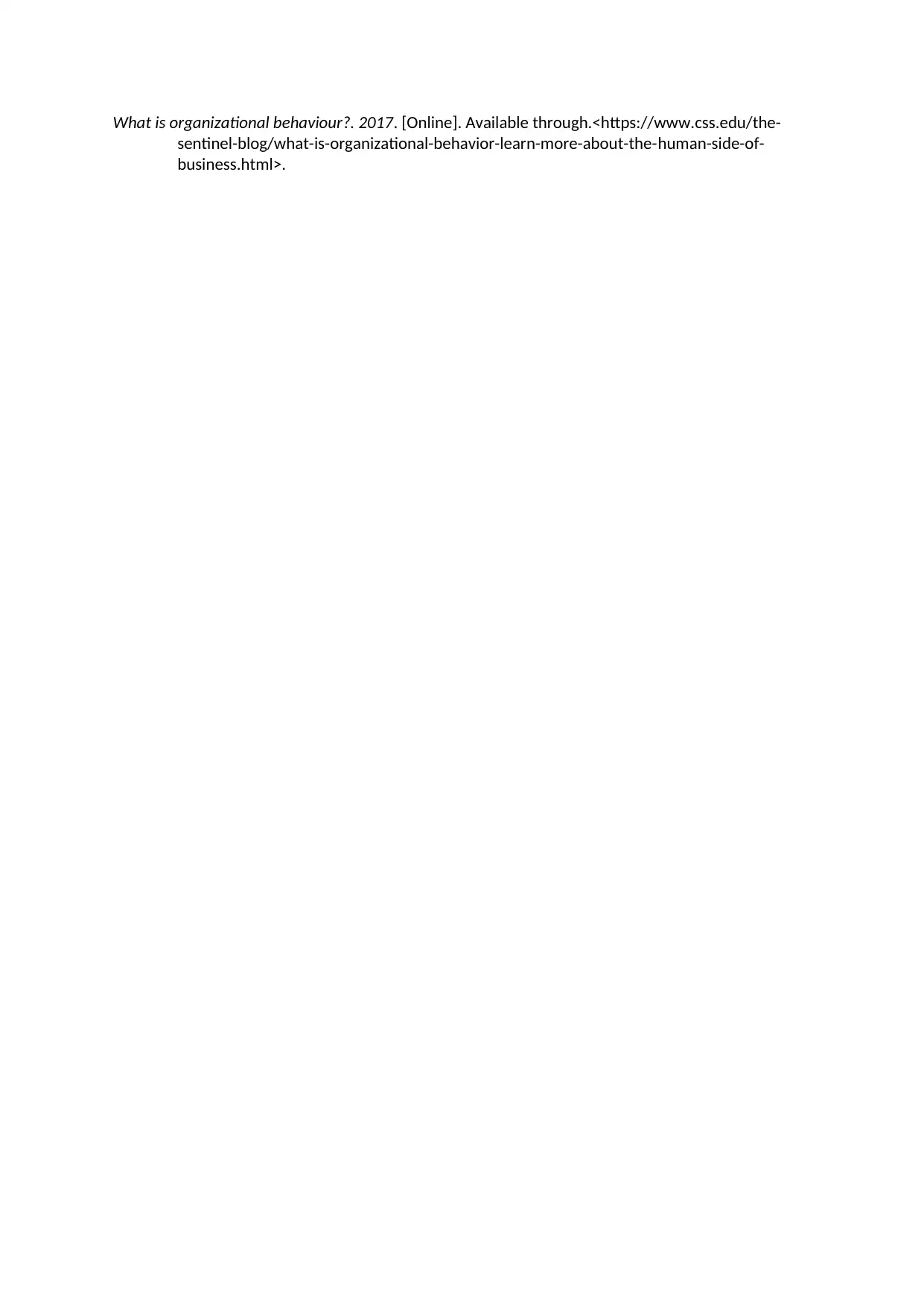
What is organizational behaviour?. 2017. [Online]. Available through.<https://www.css.edu/the-
sentinel-blog/what-is-organizational-behavior-learn-more-about-the-human-side-of-
business.html>.
sentinel-blog/what-is-organizational-behavior-learn-more-about-the-human-side-of-
business.html>.
1 out of 12
Related Documents
Your All-in-One AI-Powered Toolkit for Academic Success.
+13062052269
info@desklib.com
Available 24*7 on WhatsApp / Email
![[object Object]](/_next/static/media/star-bottom.7253800d.svg)
Unlock your academic potential
© 2024 | Zucol Services PVT LTD | All rights reserved.





